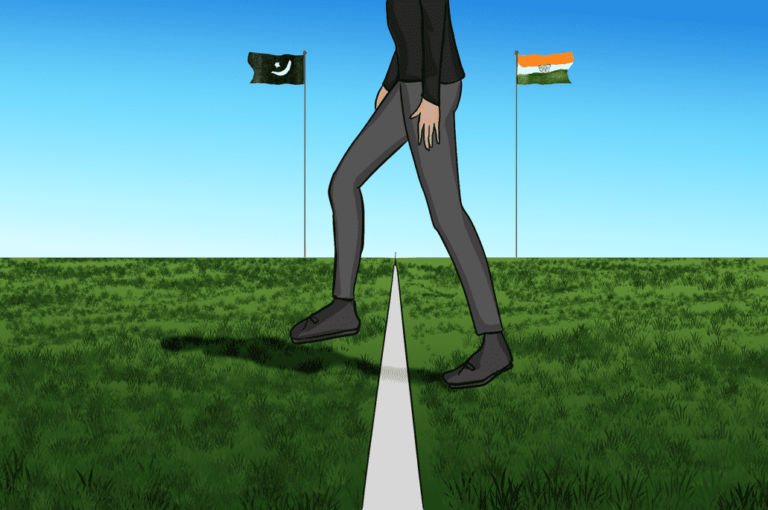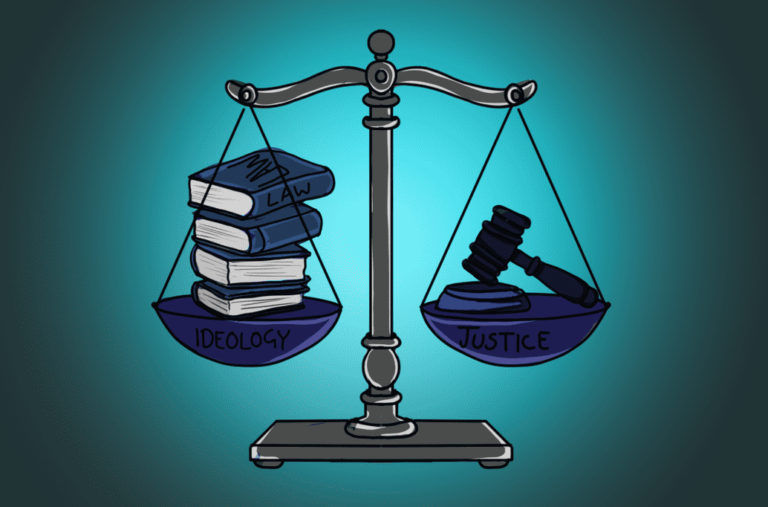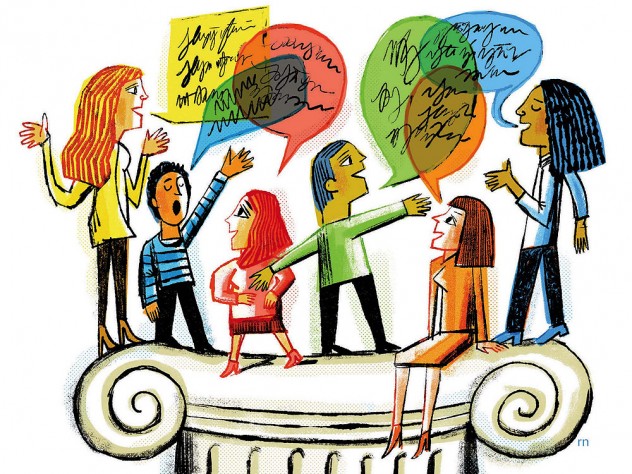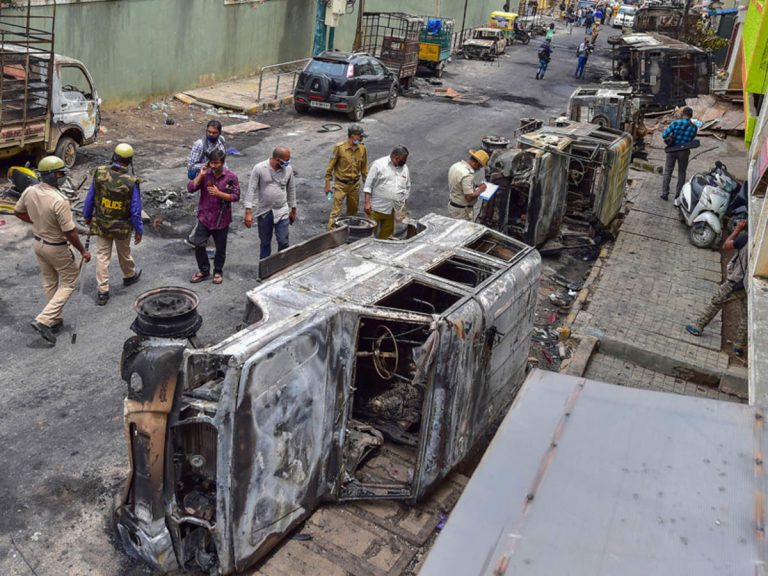Unfamiliar Side of Gandhi: On State and Non violence.
Aishi did her schooling from Diocesan School, securing the second position in the WBHSE examination (2018) and first in the Humanities section in the institution. She completed her graduation in Political Science from the St. Xavier’s College (Autonomous), Kolkata (2021). Her areas of interests include Indian Politics and Public Administration.
The nationalist movement in India had given rise to a unique figure of Gandhi who strengthened the evolution of nationalism. He indicated the space in which India could carve out her own ways in talking back to the West. This is his “Moment of Manoeuver” that concerns the critique of western civilization, “A civilization only in name”. Gandhi’s work encompassed far more than ‘politics’ as commonly understood. Most important to him was grassroots work to make Indians self-reliant, and to generate an inclusive sense of nationhood beyond religious and regional differences, and beyond social divisions and gross inequalities of wealth and status. This was what he called Swaraj or true self-rule. His original manifesto proclaimed his vision of what a new India might look like in Hind Swaraj (1909). Gandhi also came to an understanding of the possibility of peaceful resistance to wrongs of many kinds and it came to be far more than a tactic for him, and was embedded in his understanding of the nature of Truth. If no individual or group had a monopoly of understanding truth, then each must respect the beliefs and wishes of the other. Gandhi was indeed an ‘eclectically motivated’ thinker who believed in the ultra-minimalist state in his own way.
Gandhi’ s notion of Swaraj has always been holistic and an integrated whole. He aspired to have a balance in his Swaraj with all the four aspects i.e., Political Swaraj, Economic Swaraj, Socio-cultural Swaraj and Moral Swaraj, each having equal importance. The Gandhian model visualizes an upward movement of authority from the ‘base’ to the ‘apex’ in the form of circles. It is significant to note Gandhi is a philosophical anarchist, who rejects state in all its forms in his ideal order. He stands for a stateless society. (Kumar,2004). Gandhi also disputed the sufficiency of the modern state to achieve self-government rather believed that a modern state without Swaraj as self-rule would only replace British domination with indegenous domination by local elite. (Parel,1997). There is no rule for any external regulation. Hence, for all practical purposes done away with the state that exists to exert control, prohibit and punish because one is capable of self-restriction i.e, redeeming himself. However, this apparent stance against the state can be re-examined. State is not rightly discarded by Gandhi. Rather, the state, when endowed with the power of sovereignty, is required to realize his vision of Swaraj. Gandhi marginally brought in the notion of state through his conception of ‘ideal Trusteeship’ (Weber,2011) i.e, idea of the rich in society holding the surplus as a common trust for the common benefit of society. State has remained the focal point of Hind Swaraj. Gandhi did not eliminate the state in its totality rather minimized it. Morality being the supreme mover facilitates the transition from possessor to possessor of renunciation. Gandhi included both Swaraj and Su-Rajya (the good state) within the State to culminate into the notion of ‘good governance.’ State can never be a state in its already existent form such as an alien state or a coercive state. The ensuing inequalities in property and the clash of individual, private interests and judgments, which were unleashed by the liberal revolution, endangered social order. The liberal and liberal-democratic answer to this problem of social order was the invention of a political form of government, which excluded individual private judgments, i.e., the “rule of one man” (rule through an individual’s private judgment) was replaced by the republican form of government, which, with the eventual democratization of the franchise, became the liberal-democratic state. This state of the “political” is supposed to be autonomous from, or external to, the rest of social life; the standards of expediency or effectiveness of the former are assumed to be divorced from private, moral standards. His objection was to the central government administration becoming the bearer of the alienated political rights of the citizens. It should not be structured as a pyramid but in an oceanic circle. He opined that “the State will be there to carry out the will of the people, not to dictate to them or force them to do its will.” (Pantham,1983) Gandhi’s state will have the principal task to promote the basic human rights of all citizens, protect the state from external threat and promote peace and equality through institutions whose activities will be restrained by justice, equality and individual liberty as spelled out in the constitution. In his ‘Constructive Program’, there is a categorization of what elements did he want in his state and what elements he wanted to be done away with in a state. Without state, political transfer of power will not usher, hence, political independence will not take place. Gandhi’s vision of social transformation is impossible to be realized unless the sovereign Indian state works alongside civil society. Gandhi did not want his state to be aggressive based on aggressive nationalism like Great Britain and Japan. Such a state would be an impediment to individual swaraj and that would exert its power upon citizens. He connected this version of state with the modern state. Gandhi, thus, visualizes a non aggressive state based on inclusive nationalism i.e., civic nationalism, i.e., nationalism based ultimately on the sanctity of the individual rights and duties (Brown & Parel,2011) Gandhi distinguished between nature of state and individual i.e., the soul can redeem itself, can self improve and is a non-violent entity. But the state is violent and a coercive institution that represents violence in concentrated and organized form, thus, unable to reflect upon its own actions and character. The modern state allows no room for ‘soul force’, arrogating as it did to itself the monopoly of ‘body force’ or ‘brute force’. He opined that the state is a soulless machine, it can never be weaned from violence to which it owes its very existence. The new Indian state should not be a soulless machine nor violent in a concentrated form. Its foundations should be large enough to accommodate the interests of both body force and soul force. The state that is marred by vices often justifies its dubious and evil decisions at the cost of individual interest, undermining ethical and spiritual values, justifying ‘reason of state’. Hind Swaraj explicitly rejects ‘national interest’ but Gandhi does not deny its importance to state conduct rather opines that it should not be the sole factor for determining any decision. Also, There are spheres in the individual’s life that are closed off to the state. Consent does not give the state the right to enter these spheres. Obedience is owed to the state only when it acts ethically. Gandhi never wanted the state to be based on religion because for him the nation was not a homogeneous organic community, but a pluralistic political community. Hence, religious pluralism and neutrality of state should go hand in hand. (Parel,2011). Thus, if the means are not embedded in Gandhian values, then the end is not justified.
However, Gandhi also points out certain characteristics of the state that he desired to be in his state. Since the individual is highly valued by Gandhi, he cannot be concluded as a classical individualist in Western Liberal sense. He believed individuals to be the focal point of all socio-political organization and a state is to protect and further individual welfare and not interest as it would make it instrumentalist, foster a framework of rights available to people by the power of sovereignty of state. In his declaration of independence (Purna Swaraj), Gandhi clarifies the need of a sovereign state for citizens as in it is their inalienable collective right to have one and without the sovereign state, it would be impossible for them to enjoy their individual rights to freedom and material well-being. Resolution on Fundamental Rights and Economic Change (1931) also known as The Karachi Resolution is significant that embodies articles on fundamental rights including freedom of association, of speech, religious neutrality of the state and so on. The state is also the enforcer by coercive means of human rights, it had to exercise its power within the limits of natural justice and his state would be the instrument of the whole community, and not that of any particular class. States should have “the capacity to regulate national life through national representatives”. He favored a world order based on a ‘federation of friendly and interdependent states and right of the state to defend itself by military means. Parel moved ahead and referred to some isolated pieces of writings i.e., bulletins of Gandhi connected to the Right to bear Arms. Gandhi was prepared to accept the need for and possibility of a defensive war but then the relations among people in a society and of states in the international arena are not definitely symmetrical. To achieve higher ends of justice, defensive war has to be resorted. Within a small setting, Gandhi specifically endorsed the Right to bear Arms to resist injustice and to prevent one from falling prey to the oppressive behavior of others. Hence, the need for a sovereign state arises again for which Parel opined that Gandhi’s moral idealism is informed by political realism. Gandhi later on emphasized on Surajya i.e., the coercive state that worked in tandem with the non-coercive agencies of civil society, like Non-Governmental Organizations (NGOs). Gandhi assumed that Indian society was advanced enough to have a vibrant civil society. Decentralization of political power can only be achieved by village panchayats and NGOs each having different roles to play. Thus, there is a notable shift in Gandhi’s writings on ‘negative’ State that paved the way for a need for a sovereign state for good purposes by means of its sovereignty.
As Gandhi already stood for Poorna Swaraj where citizens will have the collective right to have a sovereign state to realize their individual rights to freedom and also the state will not be coercive in the hands of any one particular class rather it will be the instrument of the whole society. (Parel,2011). But within a state, there will be conflicts and injustice. Gandhi revives the political sphere by linking it to the quest for truth: politics is, for Gandhi, intrinsically a realm of truth-seeking. The challenge of politics, as with any other realm of life, is constant vigilance to ensure that even as one is epistemologically limited, one’s worldly actions accord with the seeking of truth. However, that epistemological limitation should not give rise to political paralysis: a partial grasp of the truth is an adequate and necessary way of navigating the political world. One need only follow the truth as one sees or knows it. The task of human life for Gandhi is to contemplate and work toward the best set of truths for oneself in life. Yet, because this truth is unavailable to humans in their embodied state, the challenge of politics-as for most other realms of human life-is about participating in and getting right a series of less ambitious and relative truth. If truth is multifaceted then our grasp of it will be erroneous and partial truths may conflict with each other and unless we arrive at a truth, we cannot justify the political and moral basis of that action. Amidst these challenges, lies his motion of non violence. (Godrej,2006). Similarly, the same argument has been shaped up as Gandhi urges those who have been dominated to protest actively and to struggle for their autonomy. Harmony and autonomy are intertwined with eliminating injustice, and the conflicts that he pursued aimed at all three. He wanted nonviolence to be much more than a political tactic but a way of life that rests on an understanding about the inherent worth and dignity of all life, thus tying truth and non violence i.e., non violence serves the truth and truth is god. (Terchek,2011). Gandhi also does not think about a conflict-free society; rather he prefers solving a conflict through non violence means. He seeks to disturb the routine of the day that freezes patterns of domination of their claims of legitimacy i.e., he calls upon common people to assert themselves against injustice that lies within situations of asymmetry of power. Injustice in society stems from inequality of power and violence from confusion about means and ends. When power relationships are asymmetrical, those holding a preponderance of power are often tempted to use their resources for their own advantages and they command this superiority because of established customs, access to resources, position in society and so on. It also implies that they are, also the objects of power by those above them or in other spheres of their lives reflecting the unending quest for autonomy, harmony and justice. April Carter opined that people all across the world are motivated to talk about injustice, dismantle the structures of power and injustice highlighting the continued legacy of Gandhi. Gandhi preferred ways to resist injustice not only in terms of non-violence but also by means of dialogue that will be open and honest among individuals who do not talk past each other and also to discover the absolute truth. This will be a Socratic method of dialogue based on mutual, voluntary commitments by everyone to search for the truth. Dialogue must be extended to those people who are reluctant to or do not want to talk. In disturbing the status quo, Gandhi makes it ‘costly’ to return to previously established ways of life. It is vital to disturb old ways and to mobilize unconventional power or else injustice can never be corrected. Gandhi aimed at dismantling the status quo and engagement of people but he does not do that uniformly because ‘some forms of conflict are dangerous’ (Terchek,2011). It might be because the benefits reaped from destruction of such conflicts may not lead to higher truth. Amidst injustice, conflicts prevails when citizens engaged in civil disobedience are unable to control the ones who may become violent or engaged in the same. For instance, when Gandhi’s followers became violent, he had to call off the civil disobedience movement, Chauri Chaura etc, bringing normalcy back and not prolonging the crisis further. There is a certain ‘unreality’ in a campaign that had not guarded against potential violence within its own ranks and takes too optimistic a reading of everyone who actively joined its ranks. This is one reason he insists that before any action is taken, it is necessary to assemble all of the facts to establish the justice claims of the protesters, thus, avoiding campaigns propelled by passion rather than a drive to correct injustices. In Gandhian analysis, by continuing movements at that time, there would be no worthwhile crisis following out of it which would take people to higher truth and if that not be the case, Gandhi would rather not have any interest in promoting may crisis further.
Gandhi is also acutely aware of power and gave us an intense and expanded explanation of power, it’s forms and executions. He possesses a compelling realism, untangling the relationship between consent and power. Also, term “realism” to register a theoretical coherence in Gandhi’s understanding of politics i.e., an orientation and view of the political world that would place Gandhian politics squarely within the ambit of political realism. At the core of Gandhi’s realist theory of politics was a contextual, consequentialist, and moral-psychological analysis of a political world understood to be marked by inherent tendencies toward conflict, domination, and violence. (Mantena,2012). Gandhi builds the whole concept of power based on the notion of consent and tacit consent, where he said that injustice is concrete and wherever power is lodged rests on the consent, albeit frequently the tacit consent of the members of society. For this reason, he argues that we are responsible for what we tolerate (Terchek,2011). Gandhi argues that non-violence is some kind of a limiting factor, dampens passion and brings about harmonious living which is preferable than the kind of fear that operates in violence. His notion of Satyagraha is based on adherence to truth and negation of power. For him, love is also power i.e., love derives its power through its ability to change others positively and the force of arms is powerless when marched against the force of love or soul (Parel,1997).
Gandhi’s ‘Satyagrahi’ will bring self respect to himself and also of the opponent while suffering freely without responding to the violence of the adversary. He will lay down the terms of the contest to win his adversary away from violence. To reject the terms of violence, a Satyagrahi must retain the moral superiority of non violence, a preferable form of interaction and a means to resolve conflict. According to Ronald Terchek, Gandhi is not a philosopher who believes that in all cases, exercising power is a necessary evil but he rather invokes forms of power for the powerless. Similarly, in terms of the state’s right to self defense and Right to bear arms, practitioners of nonviolence may not stand aside and look on with indifference, but must make the choice and actively cooperate or actively resist. Courage displayed in a defensive war is as much a virtue as courage exhibited in satyagraha. Both required the overcoming of the fear of death. Gandhi saw no incompatibility between the practice of ahimsa and the exercise of self-defense. (Parel,2011) Hence, power must be contextualized i.e., either welded to oppress the powerless or to preserve dignity. Gandhi rejects the relativistic stance as he judges using power in terms of its purpose and the way of its acquisition.
Conclusion
The Gandhian imperative to construct nonviolent means not only puts into sharp relief the ethical and practical dilemmas of political violence but it also prioritizes action and contexts of action in a manner that works to helpfully displace and reformulate realism’s normative bind. In a pluralist society, reasonable disagreement may exist among well-intentioned persons exercising conscientiously their powers of reason and judgment in the course of political life. To take seriously the requirement of epistemology, humility causes one to think more deeply about one’s stand than if one were simply staking out a position based on self-interest or convention. It also allows for a more reasonable and humble kind of disagreement among conscientious people-a kind of disagreement that may, in the end, be more productive than destructive to political life. The problem of conflict has less to do with substantive commitments to diverse truth claims than with the conditions under which debate over their convictions might occur. This, it might initially appear, mirrors the view of contemporary pluralists who call for rigorous engagement of conflicting viewpoints through dialogue. Gandhi’s approach to political life serves as an alternative to contemporary understandings of arbitration and justification in cases of political conflict. It provides a more realistic understanding of political life and a more productive approach toward such conflict. State because of pluralism is ought to remain engrossed in conflicts, hence, Gandhi wanted a democratic decentralization i.e., instead of hierarchically arranged pyramidal structure, his idea will be based on concentric circles where no circle would be close to another with no coercive power (Gandhi’s oceanic model of power). Gandhian perspective on state, democracy, Swaraj, non violence, liberalism and trusteeship all are closely connected.
References
Kumar, S. (2004) The Concept of State and Democratic in Gandhian Thought. Indian Political Science Association.
Parel, A. (1997) Hind Swaraj and Other Writings. New York. Cambridge University Press.
Weber, T. Gandhi’s moral economics: The sins of wealth without work and commerce without morality. in Parel, A. & Brown, J (2011). Cambridge Companion to Gandhi. New York. Cambridge University Press.
Pantham, T. (1983). Thinking with Mahatma Gandhi: Beyond Liberal Democracy.
Parel, A (2011). Cambridge Companion to Gandhi. New York. Cambridge University Press.
Godrej, F. (2006). Nonviolence and Gandhi’s Truth: A Method for Moral and Political Arbitration. Cambridge University Press
Terchek, R. Conflict and Non violence. in Parel, A. & Brown, J (2011). Cambridge Companion to Gandhi. New York. Cambridge University Press
Mantena, K. (2012). Another Realism: The Politics of Gandhian Nonviolence. American Political Science Association.







